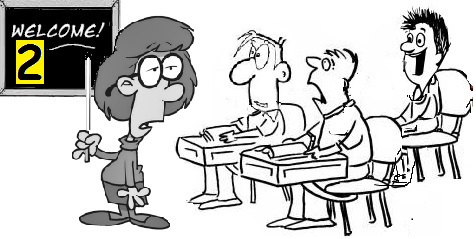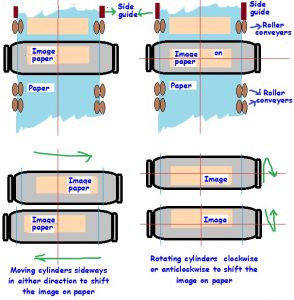Guide to printing students
-Few objective Questions and answers-
Written by : N.R. Jayaraman
Pre note:-
The articles are meant to help the students gain knowledge and effectively compete in the interviews and nothing else. Please note that these are not to be published by anyone for commercial purpose without the written permission from the author since the theme and illustrative examples have been compiled exclusively by the author for the benefit of the student community. THIS WILL BE PERIODICALLY PUBLISHED.
5) What type of feeders are fitted on the printing machines ?
Three types of feeders are fitted on the printing machines. They are:
- Fiction feeder in which the paper is pushed by a hard rubber roller or some such device in to the feed board. Examples: Small Offset machines like Romayar, Rota print Offset machine, Duplicating machines, Copiers, Digital printers etc.
- Suction feeders in which the sheets are sucked by few suckers which push them into the feeding station. Again there are two types of suction feeders fitted on the machine. One is called sheet feeder and the other is called continuous feeder. In sheet fed machine the suckers are near the front edge of the paper while in continuous feeder, the suckers are on the back edge of the paper.
- Web or Reel fed machines in which cut sheets are not fed as no feeder is fitted on the web machines. Instead reel of paper is loaded into the special paper travelling mechanism consisting of several rollers through which the paper travel and gets printed and delivered either in roll form or as cut sheets if cutting station is made available in the delivery end of the machine.
6) What is the basic difference between sheet fed machine and continuous sheet fed machines ?
In sheet fed machine the sheets are fed one after the other as the suckers fitted on the pile board suck the paper from the front edges of the piled paper and then move it into the feed board. Therefore until the first sheet sucked and forwarded fully entered into the feed board, the next sheet can not be sucked and forwarded. The production of sheets per hour will be less compared to the continuous feeder pile as one sheet after the other is only forwarded for printing.
In the continuous sheet feeder machine the suckers continue to suck the back edges of the sheets piled on the pile board at some interval and forward them into the feed table without waiting for the first forwarded sheet to completely clear the pile board. Therefore before the first sheet forwarded reaches the front lays, a part of the next sheet will continue to travel below the top sheet to reach the front lay. This process continues and thus a part of few sheets will be running one below the other to reach the front lay.
However the mechanism has been so designed that there will be no clash of sheets in reaching the front lay and till the top sheet above the next sheet below fully enters into the print station, the next sheet below will not reach the front lay. The movement of sheets have been timed so. The production of sheets per hour will be much higher in continuous feeder as compared to the sheet fed machine as one sheet after the other is continuously forwarded for printing.
7) How do you ensure that the sheets fed on the machine gets correctly aligned for register ?
The registration of the sheets are done with the help of guide mechanism in the shape of metal tabs called front and side lays fitted on the feed board. They help the travelling sheets stay in perfect right angle before being gripped by the grippers of the print station to get prints on them.
The front lay is set in such a manner that the specific amount of margin of the top edge of the sheet as pre set is maintained on all the sheets that travel and similarly the side lay is also pre set to maintain certain margin on the side edge of the sheet. Both the margins are necessary for perfect registration of the printed images and to remain allowance for trimming of the sheets to final size required.
The front lay ensures that each sheet that touches it before entering into the print station gets the print exactly in the same position on the top side. Similarly the side lay ensures that each paper that touches its side wall before entering into the print station gets the print exactly in the same position leaving specific margin on both sides. This aspect is very essential especially while printing multi colour jobs which are super imposed one upon the other.
Thus the front and side lays are positioned in such a manner that as soon as the forwarded sheet touches the front lays, immediately the side lays pulls them to to touch its side wall to ensure that the sheet travel into the print station is fully aligned at right angle for registration of the images on paper.
8) Where are the front and side lays fitted on the web fed machine ?
In the web fed machines no lays are fitted. However side guides are given to ensure that the reel of paper travel maintaining the side margin. Care is taken to prepare the layout to position the images correctly on the plate which will be fitted in a specific position on the cylinder. The correct positioning of the plate on the cylinder will ensure actual margin required on both sides. However minor adjustment of margin required is made by revolving the plate cylinder in either direction – clockwise or anti clockwise and in either directions on the sides. Some times for side margin, the web holding bar or side guides are also moved in either direction to adjust the overall margin on the reel fed into the machine.
9) Generally one sheet is only required to enter into the feed board. How will you prevent more no of sheets enter into the feed board ?
Each machine is fitted with double and triple sheet detector fitted between the pile oard and feed board on the machines which is a special device that is adjusted to allow only one sheet in the case of single sheet feeder or two to three sheets in case of continuous feeders to enter into the feed board.
This device attached on the forwarding roller will detect more than the preset no of sheets entering into the feed board and stop the machine when more than pre set no of sheet gets fed at one point of time.
The double-sheet detector can either be mechanical or electrically operated and shuts off the feeding unit and impression of the printing unit. The gap between the sheet detector and feeder roller is set either to allow a single sheet to pass trough in the case of single sheet feeder or for two sheets thickness in the case of continuous feeders.
to be continued……………3




























Recent Comments